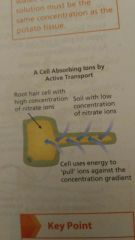![]()
![]()
![]()
Use LEFT and RIGHT arrow keys to navigate between flashcards;
Use UP and DOWN arrow keys to flip the card;
H to show hint;
A reads text to speech;
18 Cards in this Set
- Front
- Back
|
What is diffusion |
The net movement of particles from an area of high concentration to an area of low concentration, until the concentration in both areas is balanced. |
|
|
What three things affect the rate of diffusion? |
Temperature The difference in concentration (concentration gradient) Surface area of the membrane |
|
|
How to we calculate the surface to volume ratio of an organism? |
Surface Area / Volume |
|
|
Describe the SA to V ratio of single celled organisms. |
Has a large surface area to volume ratio. This allows enough molecules to diffuse in and out of the cell to meet the needs of the organism. |
|
|
Describe the SA to V ratio in multicellular organisms. |
There is a small surface area to volume ratio. |
|
|
How do multi cellular organisms cope with a small SA to V ratio? |
Surfaces and organ systems are specialised for exchanging materials:
They have a large SA
The surface is thin so that molecules diffuse a short distance
Surfaces are kept moist son substances cab dissolve and diffuse across cell membranes faster.
In animals, a rich blood supply maintains the concentration gradient.
In animals, ventilation occurs to speed up gaseous exchange. |
|
|
What happens to the SA to V ratio when the organism increases in size? |
It decreases |
|
|
What is a pattern in relation to the size of an organism and its SA to V ratio? |
The larger an organism is, the smaller its SA to V ratio |
|
|
What is Osmosis. |
The diffusion of water molecules from a dilute solution to a concentrated solution through a partially permeable membrane |
|
|
What is a dilute solution? |
A solution with a high concentration of water |
|
|
What is a concentrated solution |
A solution with a low concentration of water |
|
|
Describe the relationship between an organisms size and its SA to V ratio |
The larger an organism is, the less SA it has relative to its Volume. As the organism gets bigger, the smaller its SA to V ratio. |
|
|
Why are cells small? |
Since it is small, a cell's SA to V ratio is large. This allows more materials to move across the cell membrane, increasing the speed of the exchange of substances via diffusion. |
|
|
Why is a cell having a large SA to V ratio important? |
Since the ratio is large, the speed at which the exchange of substances occurs across the cell membrane is quick. This allows the cell to get nutrients in and waste out quickly. |
|
|
Describe the SA to V ratio of thin tissue |
Since the tissue is thin, the SA is large and the Volume is smaller in relative to the SA, meaning the SA to V ratio is larger. This means that substances can diffuse in and out of the tissue much faster There is less distance to travel and a larger surface area to maximise the amount of the substance being diffused in or out. |
|
|
What is Active Transport? |
The movement of substances from an area of low concentration to an area of high concentration. Active Transport uses energy from respiration |
|
|
How does Active Transport aid plant roots? |

It allows mineral ions to diffuse from dilute solutions in the soil into plant root hairs. |
|
|
Why does temperature increase diffusion? |
Particles gain kinetic energy, meaning they move faster. |

